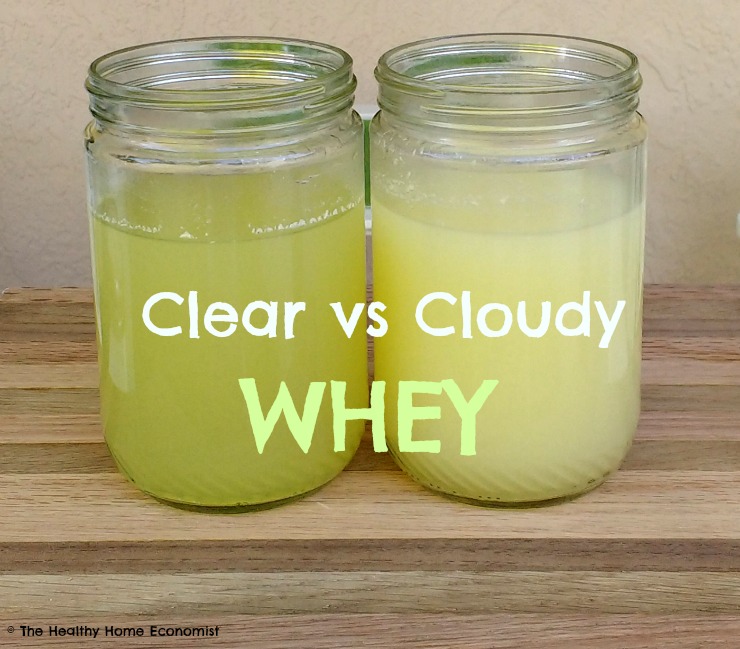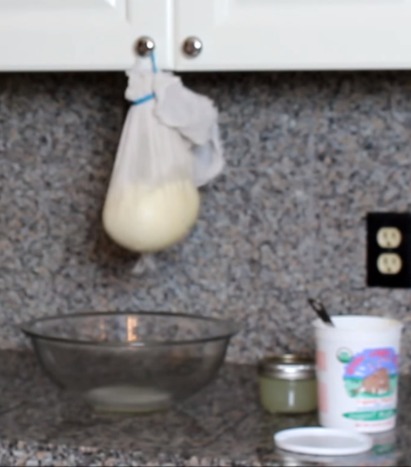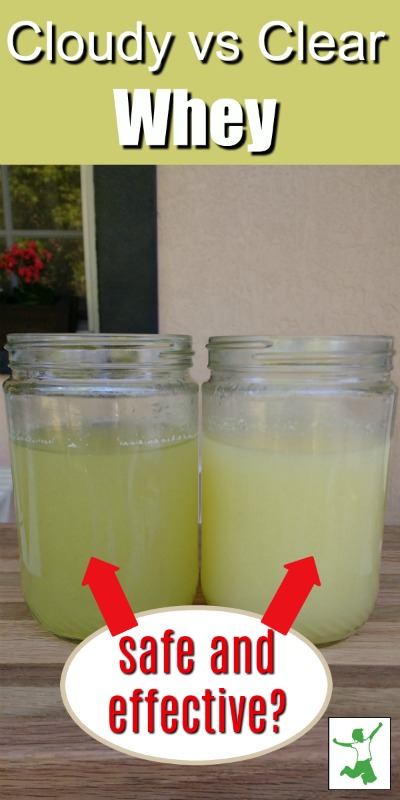
The clear liquid on the top of a newly opened container of plain yogurt is the first experience most people have with whey in its healthiest form.
This golden-colored liquid was recommended for consumption by ancient Greek physicians Galen and most especially Hippocrates, who famously said that “all disease begins in the gut”. A daily dose of the traditional elixir assisted with the restoration of health for those who suffered from gut imbalance and the myriad of illnesses that go along with it. In healthy individuals, whey helps to maintain a balanced internal ecosystem where beneficial rather than pathogenic microbes are in control of the intestinal environment.
In essence, whey was a type of traditional probiotic supplement used for many centuries before factory-produced versions came into vogue.
Whey in Traditional Cooking
Whey is commonly used as the probiotic-rich starter liquid for traditional fermentation recipes and for soaking legumes and grains before cooking to deactivate anti-nutrients, release valuable minerals, and improve digestibility.
It is also an important ingredient in a healthy baby formula recipe made with cow milk, goat milk, and a dairy-free baby formula recipe using bone broth made at home. Whey properly and carefully strained from fermented milk surprisingly does not contain any lactose and is therefore fine for many babies with a dairy intolerance.
Be advised that whey protein powder is never a healthy substitute for the real thing! Even when low temperature processed, protein powder tends to be high in (unlabeled) MSG, a residue from processing, and damaged proteins from powdering. This factory food masquerading as a health food has the potential to exacerbate autoimmune conditions or even trigger new ones over time if consumed on a regular basis.
Fortunately, people are figuring out that protein powder is not such a great idea and are turning to the liquid, whole-food versions naturally found in fermented dairy products like yogurt, kefir, and clabbered raw milk.
Making Liquid Whey (you will probably have to do it yourself)
The biggest problem with whey in its unprocessed form is that you can’t buy it at the store. Even (gasp) Whole Foods or Trader Joe’s don’t carry it.
If you’re lucky, a local raw dairy farm may have this nourishing golden liquid for sale (like mine!). Most of the time, you have to take the time to separate it yourself. This article has a recipe plus video on making raw whey. This article plus video describes the same process separating whey from yogurt. It’s an easy task, so don’t be put off by the DIY approach.
Note that whey leftover from cheesemaking is not the same as liquid separated from cultured dairy products. Cheese whey has been heated and hence has lost the probiotic and enzymatic components that are so beneficial to gut health. This is why it cannot be used for homemade formula either as it will curdle it. Cheese whey does contain many nutrients the same as its more beneficial cousin particularly potassium and vitamin B2 (1). For this reason, cheese whey makes excellent fertilizer for your backyard garden and will attract lots of worms that will improve the soil.
Whey that is Cloudy vs Clear
One of the most common problems people ask when they make liquid whey themselves for the first time is whether cloudy whey is as beneficial as clear, golden whey.
This is a very valid question. I have made whey well over 100 times and have never quite figured out exactly what causes one batch to be cloudy and the next batch clear.

One thing I have noticed is that the first bit of liquid whey separated from a fermented dairy product can frequently be cloudy while the rest will run clear. So, if cloudy whey bothers you, then simply swap a clean bowl underneath the hanging bag of fermented dairy as soon as you notice the liquid passing through the cheesecloth has become clear.
Otherwise, if you don’t have time to babysit the separation process, then rest assured that if the final product is cloudy, it isn’t a problem. It can still be used for fermentation purposes and for homemade baby formula.
Incidentally, the cloudiness is from residual casein milk proteins that escape through the cheesecloth.
Another way to obtain a clear end result is to put the jar full of cloudy whey in the refrigerator. As it settles out, you may notice the residual proteins collecting at the top. At that point, you can carefully lift off the milky white proteins with a slotted spoon or strain for a second time through a cheesecloth.

How To Enjoy the Benefits of Liquid Whey
If you love nourishing liquid whey as I do, perhaps you have wondered how to enjoy its benefits. Here are some great ideas from author Jen Allbritton to inspire you (2):
- Drink it straight or mix it in with a fermented beverage or tea (to add a probiotic boost).
- Freeze it into ice cubes and blend them into smoothies (instead of nasty protein powder!) for a more slushy texture or cool-down a beverage on a hot day.
- Replace a portion of the water used to cook grains.
- Include in the soaking water for legumes and grains to improve digestibility.
- Lacto-ferment almost anything – apples, zucchini, cabbage, cherry chutney, ginger carrots. The books Nourishing Traditions or Wild Fermentation have numerous recipes to choose from.
- Feed to pets – chickens, dogs, cats, they all can benefit from this nourishing liquid.
I also sometimes dilute it by 50% with some cold water, a squeeze of half a lemon or few ounces of orange juice, and a pinch of sea salt for an extremely hydrating, natural Gatorade on the go.








I have been a Plus member for quite some time now. And I have appreciated all I’ve learned thus far from your knowledge and content. Yesterday, I was wondering about my cloudy whey (I have three jars from three different batches of strained homemade raw whole milk yogurt whey). Not to worry…I knew to come to your site to find the answer! As you noted, I skimmed off the proteins that had collected at the top of my refrigerated whey then went on to make my fermented mayonnaise recipe. Thanks again for your excellent content!
Hi Sarah,
Can you tell me if baking whey (in bread, for example) has the safe effect as heating it above 118 degrees and destroys the probiotic benefits?
Thank you,
Kendra
Correct. All the probiotics in whey or sourdough starter are destroyed once the bread is baked. https://www.thehealthyhomeeconomist.com/sourdough-bread-myths/
Thank you for this Sarah! I’m responsible for making the whey at home for our daughter and only after I started buying milk from a third source of raw milk did I start having murky whey. It was basically impossible to strain it clear with the same cheese cloth I use with the both other two first sources I’ve bought raw milk from.
Hi! I am making curds and whey for baby formula and while it was straining the whey reached the bag so the bag was sitting in the way for a few minutes. Is it still ok, I thought I’d read somewhere to not let this happen?
Yes it’s ok, either raise the dripping height or lower the bowl.
Sarah, I hope you see this because I can’t find an answer anywhere!!
Is it possible to “make” whey simply by diluting a small amount of yogurt in water? I don’t each much plain yogurt, but I do need whey to make a probiotic lemonade drink.
So instead of buying a quart of plain yogurt and straining it and hoping to get a cup of whey, couldn’t I just dissolve some yogurt in water? And if so, about how much yogurt would you use for 1 cup of whey? 1 tsp? 1 tbs?
Many thanks for ANY help you can offer!
Hi Susan. No, you can’t make liquid whey by diluting yogurt. But, you can make whey by straining yogurt. https://www.thehealthyhomeeconomist.com/separating-whey-plain-store-yogurt/
If you don’t believe me, try your method and then attempt to ferment something with it (many recipes on this blog that use liquid whey as the starter) … you will see that the fermentation will fail.
Please consider joining Healthy Home Plus for further assistance! https://www.thehealthyhomeeconomist.com/healthy-home-plus/